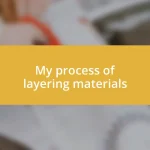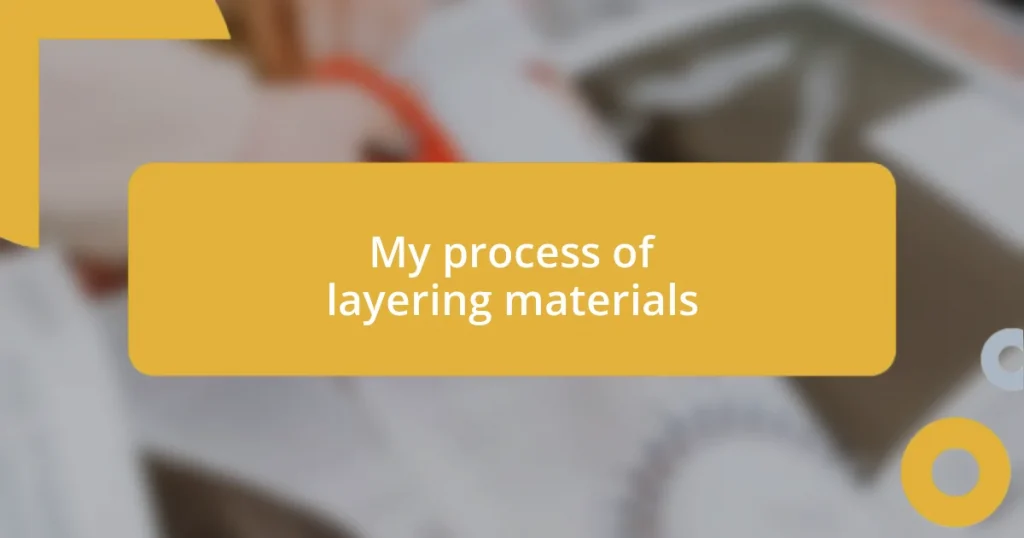Key takeaways:
- Material layering is about harmonizing different textures and properties to create depth and emotion in a composition.
- Choosing the right materials involves considering their characteristics, environmental impact, and how they interact with each other.
- Effective layering techniques include starting with a solid base, experimenting with transparency, and being mindful of negative space to maintain clarity and balance.

Understanding material layering
Material layering is a fascinating concept that transcends simple application; it’s about creating a dialogue between the different materials. Each layer brings its own character—think of it as a unique personality that contributes to the overall aesthetic and function. When I first experimented with layering, I was surprised at how much a small shift in one material could change the entire composition. Have you ever felt that thrill of discovery when mixing contrasting textures? It’s exhilarating.
I remember working on a project where I layered fabric with metal and wood. At first, I worried that the materials might clash, but surprisingly, they harmonized beautifully. This taught me that the success of layering often hinges on understanding the properties of each material. Are they rigid or flexible? Glossy or matte? The right balance can create depth and interest, pulling the viewer in. It’s about finding that sweet spot where contrast and cohesion coexist.
Understanding how each layer interacts is crucial. For instance, I’ve often encountered situations where adding one layer can bring warmth, while another might introduce coolness. Isn’t it fascinating how the same elements can evoke entirely different emotions? This interplay is what makes material layering such an art form, and it continually inspires me to explore new combinations and ideas.

Choosing the right materials
Choosing the right materials is a pivotal step in the layering process. I’ve learned that not all materials are created equal; each has its own strengths and weaknesses that can significantly affect the outcome of your project. For example, when I once paired silk and leather, the silk added a luxurious feel, while the leather grounded the design with its durability. Have you ever noticed how a small selection of materials can lead to a completely different atmosphere? It’s enlightening to see how the right blend can evoke distinct emotions, whether warmth or excitement.
When selecting materials, think about their textures, weights, and how they interact with one another. I remember a time when I tried using a lightweight fabric with heavy wood elements. The contrast was striking, yet the fabric had a tendency to sag, which shifted the overall composition. This experience reinforced my belief that considering the physical properties of each material—not just their appearance—is essential for a successful layering strategy. It’s all about maintaining harmony among the layered components.
I also consider the environmental impact of the materials I choose. For instance, I’ve made a conscious effort to incorporate sustainable resources in my layering process. This decision not only satisfies my creative desires but also aligns with my values. Has anyone else felt that sense of fulfillment when using eco-friendly materials? It really adds another layer—pun intended—to the whole experience.
| Material | Characteristics |
|---|---|
| Silk | Luxurious, lightweight, soft |
| Leather | Durable, rigid, smooth |
| Wood | Solid, warm, organic feel |
| Fabric (Cotton) | Breathable, versatile, malleable |

Preparing the workspace
Before diving into my layering projects, I make sure to prepare my workspace carefully. I’ve found that a clutter-free environment fosters creativity and allows me to focus on the intricate process of layering. One time, after an intense session where materials were strewn everywhere, I realized how much easier it is to visualize my design when everything is in its place. Setting the stage not only enhances my workflow but also inspires new ideas.
Here are some essential steps I follow to prepare my workspace:
- Clear the Surface: Remove unnecessary items for a tidy area.
- Organize Materials: Group similar materials together to simplify access.
- Gather Tools: Make sure all required tools are at hand, from scissors to adhesives.
- Good Lighting: Ensure bright and adequate lighting to see textures and colors accurately.
- Comfortable Setup: Adjust your chair and table height for ergonomic work.
Creating an inviting workspace turns every project into a more enjoyable experience. I often play my favorite music while I work; it not only boosts my mood but also helps me flow with the creative energy while I layer. I’ve found that focusing on the sound around me can transform the mundane into something motivational. The environment is just as vital to the final creation as the materials I choose.

Techniques for effective layering
When it comes to effective layering, one technique that I swear by is starting with a solid foundation. I remember the first time I layered fabrics for a project; I began with a canvas backing, which provided the necessary support and anchored everything above it. Have you ever considered how a strong base can make all the difference? This foundation allows the subsequent layers to shine, creating depth without compromising the overall structure.
Next, I play with transparency by incorporating sheer materials. A particularly memorable project involved layering delicate organza over a bold print. The transparent layer softened the look while enhancing colors beneath it, creating a visually engaging effect. This kind of experimentation sparks creativity—if you’ve never tried it, I encourage you to play with different levels of opacity and see how they interact!
Another essential technique is to vary the dimensions and shapes of your layers. Instead of sticking to uniform pieces, I often cut materials into varying sizes. For instance, when I worked on a mixed-media canvas, I used both large squares and small snippets of fabric to create a dynamic composition. The contrast kept the viewer’s interest and added a playful touch to the piece. Have you thought about how changing dimensions can inject energy into your project? Just imagine the possibilities you can unlock!

Tips for achieving desired effects
To achieve the desired effects in your layering, consider experimenting with color gradients. I vividly recall working on a piece where I blended shades of blue and green by layering tissue papers. The transition from one color to another added depth and movement to my project, creating an almost water-like effect. Have you thought about how subtle variations in color can transform your work? It’s truly fascinating to see how different hues interact with one another.
Textures are also an essential factor in layering. In a project I was proud of, I combined smooth fabrics with rough, textured ones to create contrast. The interplay of these materials added dimensionality and invited touch, making the finished piece more engaging. Think about the emotions you want to evoke—is it softness, vibrancy, or perhaps a rugged feel? Selecting contrasting textures can be a powerful tool in your creative arsenal.
Lastly, don’t underestimate the impact of negative space. I learned this lesson during a particularly challenging art piece where I focused heavily on filling every inch with materials. It wasn’t until I intentionally left areas untouched that the composition truly came to life. Have you found yourself trying to fill every space? Sometimes, less is more, allowing the eyes to rest and enhancing the overall aesthetic. Embracing negative space can provide balance and make your layers stand out even more.

Common mistakes to avoid
It’s easy to get caught up in layering too many materials without considering their harmony. I once dove headfirst into a project, adding layer after layer until my canvas felt overcrowded. In hindsight, the overwhelming complexity detracted from the beauty of each individual piece. Have you ever experienced that moment when you realize simplicity can often speak louder than chaos? Striking the right balance among layers is key to maintaining clarity in your project.
Another mistake I made early on was neglecting to plan the layering order. I layered fabrics spontaneously, only to realize later that the bottom piece wasn’t suited for what I envisioned on top. I honestly spent hours adjusting and cursing my lack of foresight. It’s a simple step but drafting a quick sketch of your intended layout can save so much frustration. How often do we overlook the power of a plan? A thoughtful layout can streamline your process and make layering more intuitive.
Also, be wary of using materials that don’t adhere well to each other. I once used a lovely fabric that refused to hold onto the adhesive, leaving me with a messy project and a sinking feeling in my gut. Since then, I’ve learned to test how different materials interact—play around with adhesives and see what combinations yield the best results. Isn’t it surprising how something as straightforward as material compatibility can make or break your layering experience? A little testing in advance can go a long way in ensuring your final piece holds together beautifully.

Finalizing and finishing layers
Once I reached the final layers of a project, I realized how crucial it was to step back and assess the overall composition. It’s like preparing a meal; sometimes you need to let the flavors blend before serving. Have you ever added a finishing touch only to realize it muddles the entire piece? Taking a moment to evaluate can help ensure that each layer harmonizes beautifully with the others.
In my experience, a good finishing technique can elevate the entire work. When I applied a clear varnish to a multi-layered collage, it not only intensified the colors but also gave the piece a polished look. The transformation was astonishing! Have you considered how a finishing touch can radically change the perception of your work? Finding the right finish is where your personal style really shines through.
Finally, I’ve learned the importance of protective measures. After completing a delicate layered project, I was horrified to see it barely survived the transport to an exhibition. Sometimes, I wonder how something so beautiful can be so fragile. Investing in the right protective layer, whether it’s a frame, cover, or even a simple wrap, can safeguard your hard work and ensure it’s appreciated for years to come. What would your masterpiece look like if you took those extra steps for protection? It’s worth the effort to preserve what you’ve created.












